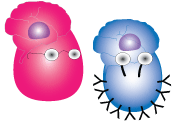
Antibody class-switching
There is another process taking place in the germinal centre that also affects antibody production called class (or isotype) switching. During antibody production, cytokines produced by the Th cells and the presence of CD40L on the T cells cause the double-stranded DNA to open up as if yawning. This permits access to enzymes that cut the DNA strands in several places. This fragmentation allows the currently used constant region genes, for example M, to be thrown out and destroyed while positioning another constant region gene, for example E, next to the already rearranged variable region genes. The result is a new antibody isotype, IgE in this case, with unchanged antigen specificity. This process is called isotype switching. Different cytokines make the DNA open up at different places along the constant region stretch of DNA and will therefore facilitate the production of different antibody isotypes. For example, IFN-γ makes the DNA strands yawn so that the D and M constant regions can be replaced with the G1 constant region making IgG1. Likewise, IL-4 promotes production of IgG4, IL-5 of IgA and IL-13 of IgE. But why do we need antibodies of different isotypes? Take a look at this video and see if you can find some clues.

With the different constant regions, different isotypes can bind to different Fc-receptors allowing them to home to different tissue sites. In this way IgA and IgM antibody gets transported across epithelial layers into the respiratory, gastrointestinal, urogenital tracts and breast milk, and IgG is allowed to cross the placenta from mother to fetus. With the different constant regions antibodies also become structurally different. IgM producing plasma cells tie 5 IgM antibodies together inside the cell and secrete them as a pentamer. IgA can be secreted either as a dimer or a monomer, while IgG is secreted as a monomer. The structural differences also influences the isotype functions which the video has already touched upon and which you can find out more about in the next page.